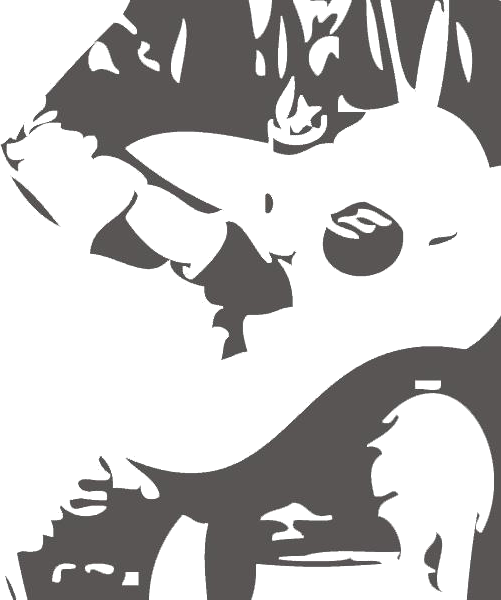This guitar is branded Maurer on the inside back strip, and also PAT. JULY 12 1904. This indicates that the guitar was made by the Larson Brothers, Carl and August, in Chicago. Another brand on the back strip reads: Manufactured by Maurer & Co. Expressly for Percy S. Foster Piano Co. 1330 G St. Washington DC. Foster was a piano retailer working in Washington DC and it’s very likely that this guitar was originally sold in his G St. store. Additionally, there is an ink-stamped serial number on the back strip: 22696. The Larson Bros. serial number list, published in the text The Larsons’ Creations, is known to be somewhat inconclusive. The serial number of this guitar, when compared to that published list, would date it to circa 1917, which fits the Foster Piano Co. timeframe.
The top of the guitar is made from spruce. It features several layers of black, white, red and ‘rope’-style purfling bordering abalone inlay, and bound in white celluloid. The same appointments extend to the sound hole and around the finger board extension.
The back and sides are book-matched Brazilian rosewood. The back features multiple layers of b/w/b purfling bound in white celluloid, and a colorful purfling strip down the center. The five-piece neck is mahogany, with a center strip of what looks like ebony and a white wood, possibly holly or maple. The neck profile is carved in a modern-feeling ‘C’ shape and features a white celluloid heel cap set off with b/w/b purfling. The fingerboard is Brazilian rosewood inlaid with a profuse and decorative pearl ‘tree of life’ inlay that runs the length of the board and typical of Larson ornamentation on their higher-end guitars. The neck is bound in white celluloid, the celluloid shortened to expose a small facet of the lower part of the ebony board, another Larson Bros. hallmark. The tuners appear original to the guitar and are a high-grade, engraved set of three-on-a-strip tuners with pearl buttons. The slotted head stock is overlaid with Brazilian rosewood, bound in white celluloid and is inlaid with an elaborate pearl design. The bridge appears to be a replacement, made from ebony, and features an eight-lobed flower-like design on each ‘flat pyramid’. It’s our opinion that this inlay is not original to the guitar, since no similar inlays can be found in any published sources. The Larsons often used stars, or four or six-lobed inlays on their bridges.
These appointments, including the pearl tuner buttons, indicate that this guitar is a Maurer Style 595, the highest grade produced as a regular production model.
It’s often difficult to date Larson creations because the brothers essentially ran a two-man shop and were very consistent with guitar appointments over the decades. A guitar made in 1915 could look exactly like one made in 1935. Additionally, there are scant catalogs extant that could help pinpoint a date. The Larsons rarely advertised, so old publications are not a resource. However, the Percy S. Foster brand is a fortuitous clue. Foster sold his Washington DC business to a buyer in Chicago in 1917. This allows one to conclude that this particular guitar dates to 1917 or earlier. Another clue to the date is the laminated neck and braces, which were first used by the Larsons beginning 1904. Therefore, it can be safely concluded that this guitar was made sometime between 1904 and 1917.
Internally, the top is X-braced with the X-braces laminated in ebony or rosewood, which is a hallmark of high-end Larson Bros. guitars. The bridge plate appears to be original, with an added veneer overlay. The two lateral top braces above the sound hole are supported by two recently installed ‘popsicle’ braces and a mahogany cleat under the area of the sound hole.
The body measures 15” across at the lower bout. Scale length is 25 11/16”. The neck measures 1 7/8” across at the nut, and string spacing is 2 1/4” across at the saddle.
The guitar appears structurally sound, in excellent playing condition, with some nicks and dings from time and wear. The finish was closely examined under both natural light and UV light. It’s our opinion that the finish is the original varnish or shellac favored by the Larson Bros. Where the neck curves into the heel there is a slight fissure, about 1/2”, that runs through the neck laminations (see photo). Other than the replacement bridge and inlay, extra braces, back cracks and cleats, there are no other visible repairs. It appears that the neck was reset in the past. The action is good with a generous amount of saddle remaining. Remarkably, this guitar has had only two owners in its history. The original purchaser was said to be a symphony conductor in Washington DC. The second owner was acclaimed banjo player and instrument collector Reed Martin.The guitar retains an early green-lined Geib hard case in excellent condition.
Sound clip coming soon!

